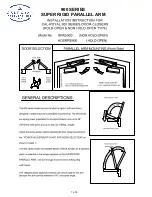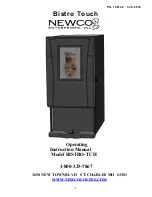
ProTIG 500 AC/DC
Operating Manual
Page 31
5. TIG Calotte / electrode diameter (LED 20)
Here, the calotte diameter (ball) used in TIG AC or the electrode diameter
in TIG DC can be adjusted, so that the machine can use the optimum ignition
parameters at start up. Tap on the key diameter (item 5), LED flashes,
and select with the knob (item 8) the used diameter. Tap again on the key
diameter (item 5), LED stops flashing.
The following diameters can be adjusted: 1.0, 1.6, 2.4, 3.2, 4.0mm
The calotte diameter should be less than or equal to the electrode diameter.
The lager the diameter of the calotte is, the higher is the energy of the starting pulse.
NOTE: If the diameter is too large, parts of the tungsten electrode can cut off at the Start!
In this case, the calotte diameter has to be reduced by one level,
to reduce the wear of the electrode.
6. AC wave type (only for AC machines in welding process AC (LED 20)
It is possible to select 4 different waveforms for aluminium welding depending on
the field. By tapping on the button AC wave type (item 6), it is possible to switch
between the wave forms. The corresponding LED is light.
The display shows always the mean value of the current.
1. Square (LED 60):
all sheet metal thicknesses, high arc stability, high cleaning efficiency, higher noise levels
2. Mixed (LED 61) / 3. Triangle (LED 62):
for thin to medium sheet metal, longer service life of the electrode, normal cleaning effect, better thermal
control of the arc –
Triangle value from 10A to 290A (mean value) / (peak = 500A)
4. Sinus (LED 63):
for thin to medium sheet metal, low noise levels, normal cleaning effect, smooth arc,
suitable for butt welding
Sinus value from 10A to 350A (mean value) / (peak = 500A)
7. Pulse type
By tapping on the button pulse type (item 7), it is possible to switch between the pulse types.
The corresponding LED is light.
3 different pulse types are available:
1. Pulse AUTO (LED 70) – only for welding process DC:
In automatic pulse method it is possible to set a pulse frequency from
19Hz to 540Hz. In this method of pulse welding, the welding current is
automatically adjusted to the pulse frequency and vice versa.
The setting of the parameters is described under Point 4 - functions.
In DC process the following parameters can be set:
Pulse main current Ip: 10 – 500A (corresponds main current I1)
Pulse frequency f:
19Hz to 540Hz
2. Pulse SPEED (LED 71) – only for welding process DC:
In the fast SPEED pulse method, a pulse frequency of 0.2kHz to 2.5kHz (2500Hz) can be set.
The setting of the parameters is described under Point 4 - functions.
In DC process the following parameters can be set:
Pulse main current Ip: 10 – 500A (corresponds main current I1)
Pulse base current Ib: 5 – 500A
Pulse frequency f:
0.2kHz to 2.5kHz (2500Hz)
3. Pulse MAN (LED72) – for welding process DC and AC:
In the manual pulse method, a slow pulse frequency (1Hz to 10Hz or 100Hz) can be adjusted.
The setting of the parameters is described under Point 4 - functions.
In DC process the following parameters can be set:
Pulse main current Ip: 10 – 500A (corresponds main current I1)
Pulse base current Ib: 5 – 500A
Time pulse current Tp: 0.01 – 1.00s (100Hz – 1Hz)
Time base current Tb: 0.01 – 1.00s (100Hz – 1Hz)
5- Calotte diameter
6 - AC wave type
60 - Square
61 - Mixed
63 - Sinus
62 - Triangle
AUTO
MAN
SPEED
7 - Pulse type
70 - Synergic Pulse
71 - Fast Pulse
72 - Slow Pulse















































